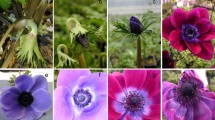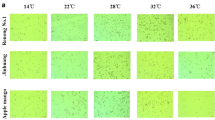Abstract
The influence of salinity, given at germination (stage I) or 75 d after sowing (stage II), on flower production and characteristic features of male reproductive structures was studied in three promising genotypes of chickpea (Cicer arietinum L. cv. ICCV 88102, H 82-2 and C-235). In ICCV 88102 and H 82-2 salinity 20 meq 1-1 increased the number of flowers when applied at both stages whereas in C-235 only when applied at the later stage. The salinity also delayed flowering; the higher salinity the greater was delay in flowering. In H 82-2 and C-235 salinity treatment given at stage II (when few flower buds appeared) hastened the flowering. The salinity curtailed pollen production; the reduction being minimum in C-235 and maximum in H 82-2. Germination was not significantly affected in C-235 pollen collected from plants grown under salinity conditions upto 60 meq 1-1 applied at stage I but the tube elongation was inhibited. The inhibition of tube elongation was greatest in C-235. Salinity treatment administered at stage II did not affect significantly pollen germination excepting C-235 in which a consistent decline with increasing salinity was evident. Salinity stimulated tube growth in ICCV 88102. Na2SO4 in the germination medium was more detrimental for both pollen germination and tube growth than NaCl.
Similar content being viewed by others
References
Datta, K.S., Dayal, J. Goswami, C.L.: Effect of salinity on growth and yield attributes of chickpea -(Cicer arietinum L). - Ann. Biol.3: 47- 53, 1987.
Datta, K.S., Sharma, K.D.: Effect of chloride and sulphate types of salinity on characteristics of chlorophyll content, photosynthesis and respiration of chickpea (Cicer arietinum L.). - Biol. Plant.32: 391–395, 1990.
Dhingra, H.R.: Physiological and biochemical studies on the effect of salt stress on maize(Zea mays L.) pollen. - Ph.D. Thesis, Haryana Agricultural University, Hisar 1984.
Dhingra, H.R., Sharma, P.K.: Reproductive performance of pea(Pisum sativum L.) under saline conditions. - Indian J. Plant Physiol.35: 198–201, 1992.
Dhingra, H.R., Varghese, T.M.: Effect of salt stresss on viability, germination and endogenous level of some metabolites and ions in maize(Zea mays L.) pollen. - Ann. Bot.55: 415–420, 1985.
Hauser, E.J.P., Morrison, J.H.: The cytochemical reduction of nitroblue tetrazolium as an index of pollen viability. -Amer. J. Bot.51: 748–752, 1964.
Kaddah, M.T., Ghowail, S.Z.: Salinity effects on the growth of corn at different stages of development. - Agron. J.56: 214–217, 1964.
Kapoor, S., Nair, P.K.K.: Pollen production in some Indian vegetable crops. - Gcobios1: 71–73, 1974.
Lauter. D.J.. Munns. D.N.: Salt resistance of chickpea genotypes in solution salinizcd with NaCl or Na2SO4. - Plant Soil95: 271–279, 1986.
Manchanda, H.R., Sharma, S.K.: Tolerance of chloride and sulphate salinity in chickpea(Cicer arietinum). - J. agr. Sci.113: 407–410, 1989.
Manchanda, H.R., Sharma, S.K.: Influence of different chloride : sulphate ratios on yield of chickpea(Cicer arietinum) at comparable salinity levels. - Indian J. agr. Sci.60: 553–555, 1990.
Manchanda, H.R., Sharma, S.K, Mor, R.P.: Relative tolerance of pulses for chloride and sulphate salinity. -Indian J. agr. Sci.61: 20–26, 1991.
Namuco, O.S., O’Toole, J.C.: Reproductive stage, water stress and sterility. I. Effect of stress during meiosis. -Crop Sci.26: 317–321, 1986.
Sharma, P.K.: Studies on the reproductive behaviour of mungbean(Vigna radiata (L.) Wilczek) under saline conditions. - M.Sc. Thesis,-Haryana Agricultural University, Hisar1992.
Sheoran, I.S., Garg, O.P.: Effect of different types of salinities on gram(Cicer arietinum L.) during germination. 1. Seedling growth and water relations. - Indian J. Plant Physiol.26: 363–369, 1983.
Shivanna, K.R., Linskens, H.F., Cresti, M.: Pollen viability and pollen vigor. - Theor. appl. Genet.81:38–42, 1991.
Swami, A.V.S.R., Khanna, V.K.:In vitro pollen germination and pollen tube growth in chickpea. - Int. Chickpea Newslett.24: 24–25, 1991.
Wilson, D.C., Reisenaucr, H.M.: Cobalt requirement of symbiotically grown alfalfa. - Plant Soil19: 364–373, 1963.
Author information
Authors and Affiliations
Rights and permissions
About this article
Cite this article
Dhingra, H.R., Varghese, T.M. Flowering and male reproductive functions of chickpea (Cicer arietinum L.) genotypes as affected by salinity. Biol Plant 35, 447–452 (1993). https://doi.org/10.1007/BF02928525
Received:
Accepted:
Issue Date:
DOI: https://doi.org/10.1007/BF02928525




